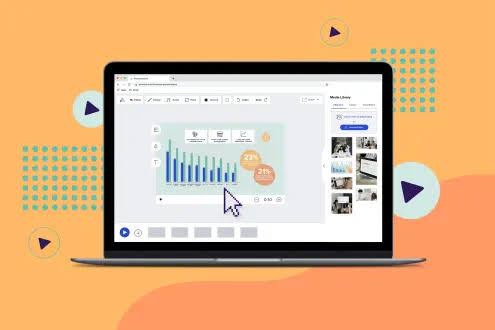How to Create Interactive Presentations with a Video Presentation Maker

Interactive presentations have become essential in today’s digital era, allowing presenters to engage their audience in dynamic and compelling ways. Traditional static slides are giving way to video presentations that offer a richer, more engaging experience. Utilising a video presentation maker can transform your content into a captivating visual journey. This blog explores the steps to create interactive presentations that can capture your audience’s attention and enhance their learning experience.
Understanding the Basics of Video Presentation Makers
Before diving into creating your presentation, it’s crucial to understand what a video presentation maker is. These tools are designed to combine various multimedia elements such as text, images, video clips, animations, and interactive features into a cohesive presentation. Create video presentations with a video presentation maker. Just enter a prompt, and our AI will write a script, find the right footage, and add text and background music automatically. You can then use an easy editor to add the final touches. Unlike traditional slide-based software, video presentation makers allow for seamless integration of dynamic content, enabling you to craft stories that resonate more deeply with your audience.
Choosing the Right Video Presentation Maker
The first step in creating an interactive presentation is choosing the right video presentation maker. There are numerous options available, each with its unique features and capabilities. Look for a tool that offers intuitive drag-and-drop functionality, a wide range of templates, and the ability to incorporate various multimedia elements. Popular choices include Invideo, Prezi, and Powtoon, each catering to different presentation styles and needs. Ensure that the tool you select aligns with your presentation goals and your audience’s preferences.
Planning Your Presentation Content
Effective presentations require meticulous planning. Begin by outlining the main points you want to cover. Consider the story you want to tell and how each segment of your presentation will contribute to that narrative. Think about your audience’s needs and expectations, and tailor your content to meet those criteria. Structuring your presentation with a clear beginning, middle, and end will help maintain coherence and ensure that your message is conveyed effectively.
Creating Engaging Visuals
Visuals play a critical role in video presentations. High-quality images, graphics, and video clips can significantly enhance your content’s appeal. Use visuals to complement and emphasise your points rather than cluttering the screen. Tools are used alongside your video presentation maker to create custom graphics and infographics. Remember, the key is to use visuals that are relevant and add value to your presentation, not just for decoration.
Incorporating Interactive Elements
Interactivity is what sets video presentations apart from traditional slides. Features such as clickable links, quizzes, polls, and interactive diagrams can engage your audience actively. For instance, embedding a quiz at the end of a section can help reinforce learning and gather feedback. Tools like Mentimeter or Slido can be integrated to create real-time polls and Q&A sessions, making your presentation more dynamic and participatory.
Adding Animations and Transitions
Animations and transitions can make your presentation more fluid and engaging. Use them to highlight key points, illustrate processes, or simply keep your audience’s attention. However, it’s important not to overdo it—too many animations can be distracting. Stick to simple, smooth transitions that enhance the storytelling aspect of your presentation. Most video presentation makers come with built-in animation effects that you can easily apply to your slides.
Integrating Video Clips
Video clips can add a powerful dimension to your presentation. They can be used to demonstrate concepts, share testimonials, or break up the monotony of text-heavy slides. Ensure that the videos you include are high-quality and relevant to your content. You can either use existing videos or create your own using tools like InVideo or Animoto. Keep video clips short and to the point to maintain your audience’s interest.
Utilising Background Music and Sound Effects
Background music and sound effects can enhance the overall atmosphere of your presentation. Choose music that matches the tone of your content—upbeat tracks for lively topics and softer music for serious subjects. Sound effects can also be used to emphasise certain points or transitions. Be mindful of the volume and ensure that the audio does not overpower your narration or main content. Many video presentation makers offer a library of royalty-free music and sound effects.
Crafting a Compelling Narrative
A compelling narrative is the backbone of any successful presentation. Begin with a strong introduction that captures your audience’s attention. Follow this with a well-structured body that logically flows from one point to the next. Use storytelling techniques to make your content more relatable and memorable. Finally, conclude with a powerful closing that reinforces your main message and leaves a lasting impression. Practise your delivery to ensure that your narrative flows smoothly.
Personalising Your Presentation
Personalization can make your presentation more engaging and relatable. Address your audience directly and use examples that are relevant to them. Incorporate personal anecdotes or case studies to illustrate your points. Customising your content to the specific interests and needs of your audience can significantly increase engagement and impact. Use the personalization features available in your video presentation maker to add a personal touch to your slides.
Testing and Refining Your Presentation
Before presenting to your audience, it’s essential to test and refine your presentation. Run through it several times to ensure that all elements work seamlessly. Check for any technical issues, such as broken links or audio problems. Gather feedback from colleagues or friends and make necessary adjustments. Practise your delivery to ensure that you are comfortable with the content and can present it confidently. Testing and refining can help you deliver a polished and professional presentation.
Engaging Your Audience During the Presentation
Engagement doesn’t stop at the design stage—it continues during the presentation itself. Encourage audience participation by asking questions, prompting discussions, and inviting feedback. Use the interactive features you’ve incorporated, such as polls and quizzes, to keep your audience actively involved. Pay attention to your audience’s reactions and adjust your delivery accordingly. Engaging your audience throughout the presentation can enhance their learning experience and make your content more impactful.
Leveraging Analytics and Feedback
After your presentation, leverage analytics and feedback to evaluate its effectiveness. Many video presentation makers offer analytics features that allow you to track viewer engagement and identify which parts of your presentation were most effective. Use this data to refine future presentations. Additionally, gather direct feedback from your audience to understand their perspectives and make improvements. Continuous evaluation and improvement can help you create more effective presentations over time.
Benefits of Using Video Presentation Makers
Using video presentation makers offers numerous benefits. They allow for greater creativity and flexibility, enabling you to create visually stunning and engaging content. These tools often come with built-in templates and assets, saving you time and effort. Additionally, video presentations can be easily shared and accessed across different devices, making them ideal for remote or hybrid environments. The ability to incorporate interactive elements also enhances audience engagement and learning.
Real-World Applications of Video Presentations
Video presentations can be used in a variety of contexts, from business meetings and educational settings to marketing and training. In business, they can be used to pitch ideas, present reports, or train employees. In education, they can enhance classroom learning and support remote teaching. Marketing teams can use video presentations to create compelling content that captures their audience’s attention. The versatility of video presentations makes them a valuable tool across different industries.
Overcoming Common Challenges
Creating interactive video presentations can come with its challenges. Technical issues, such as compatibility and playback problems, can arise. To overcome these, ensure that your presentation maker is up-to-date and compatible with your devices. Time constraints can also be a challenge—planning and structuring your presentation efficiently can help manage this. Finally, balancing interactivity without overwhelming your audience is key—focus on quality over quantity when incorporating interactive elements.
Future Trends in Video Presentations
The future of video presentations is likely to be shaped by advancements in technology. Emerging trends include the use of artificial intelligence to create more personalised and adaptive presentations. Virtual and augmented reality are also set to play a significant role, offering immersive experiences that traditional presentations can’t match. Staying abreast of these trends and incorporating them into your presentations can help you stay ahead of the curve and create more impactful content.
Conclusion
Creating interactive presentations with a video presentation maker can transform your content into an engaging and memorable experience. By understanding the basics, planning effectively, and utilising the various features available, you can create presentations that captivate your audience and convey your message powerfully. Embrace the creativity and flexibility offered by video presentation makers to take your presentations to the next level. With practice and continuous improvement, you can master the art of interactive presentations and leave a lasting impression on your audience.



